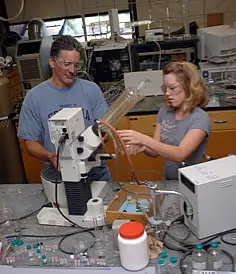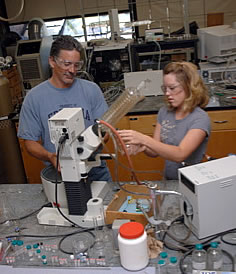



SUNY Fredonia has landed a couple of big fish, so to speak, in Great Lakes environmental research with the receipt of major grants from the Environmental Protection Agency and National Science Foundation.
The university, through Dr. Michael Milligan in the Department of Chemistry and Biochemistry, has been awarded a $157,000 grant to purchase state-of-the-art laboratory analytical equipment designed to detect very small concentrations of pollutants in fish, water, sediment and air.
 |
| Dr. Michael Milligan with senior Biochemistry major and student researcher Alexandra Orchard |
Though welcomed at SUNY Fredonia, the National Science Foundation Major Research Instrumentation grant represents just one small aspect of a very large research activity to be undertaken by SUNY Fredonia faculty and students over a five-year period. The Environmental Protection Agency awarded a $1.75 million research grant to SUNY Fredonia and two other universities to prepare assessments of pollutant levels in fish found in all five Great Lakes.
The objective of the Great Lakes Fish Monitoring program, established in the early 1970s, is to gauge contaminant levels in fish over an extended period of time. The program, administered by the EPA division in Chicago, awards research projects, each lasting five years, to educational institutions.
“It’s a great opportunity for my students to work on this project and gain valuable research experience. They will present at research conferences and be co-authors in scientific journals,” said Dr. Milligan, professor of chemistry and biochemistry and principal investigator for the project. It’s also the most ambitious project that Dr. Milligan has been associated with during his 14 years at SUNY Fredonia.
Dr. Milligan and colleagues at SUNY Oswego and Clarkson University, which are also sharing in the highly sought EPA grant, are entering the second year of the five-year study. That collaborative arrangement among the three universities figured prominently in their grant application being approved, Dr. Milligan suggested.
“Many funding agencies are now looking for interdisciplinary approaches to research problems as opposed to single-investigator initiated projects. They are looking for a team of investigators, where each member brings a different background to the table. A lot of scientific research is heading in that direction,” Dr. Milligan explained.
“We each have our own responsibilities, we each have different talents,” Dr. Milligan explained. “We all complement each other and have worked 10 years together with each other on many different projects. This grant was the culmination of a lot of hard work and cooperation.”
SUNY Fredonia’s specialty, Dr. Milligan noted, is analytical work, or measuring minute quantities in different environmental media.
The National Science Foundation grant will be used by SUNY Fredonia to purchase a gas chromatograph/mass spectrometer, a highly sophisticated tool capable of measuring extremely low levels of contaminants – as small as 1 part per trillion. That makes the new device 10 to 100 times more sensitive than the current GC/MS at SUNY Fredonia, Dr. Milligan said. Other complementary instrumentation will be purchased for collaborators at SUNY Oswego. Each of these state-of-the-art instruments will be used for research and educational activities at both campuses.
“These instruments are a significant upgrade from what we have now,” he noted. “For example, I have a GC/MS that’s 11 years old, also funded by a similar NSF grant, but that instrument is getting obsolete, is entering the end of its useful lifetime.”
Award of the grant is very timely, Dr. Milligan noted, as the new GC/MS will augment Great Lakes research launched a year ago at the schools. The devices, expected to arrive during October, will perform different assessments.
Viewers of television programs such as CSI hear references to GC/MS devices, which investigators use to analyze levels of drugs or other substances found in bodies of crime victims.
Fish monitoring studies in the Great Lakes focus on persistent bioaccumulative toxins found in fish. These substances are released into the environment in the form of pollutants, industrial discharges, hazardous wastes and precipitation. They seep into rivers and streams and are carried into the Great Lakes, where they make their way up the aquatic food chain.
The purpose of the five-year study is to monitor these toxins in sport fish, such as walleye, so regulatory agencies have data to analyze for potential consumption guidelines. In addition, top predator fish will also be analyzed to assess overall pollution levels in the Great Lakes. “These compounds accumulate in fish, so it’s an effective way to get a good measure of how much pollution there is in the Great Lakes,” Dr. Milligan said.
Some fish to be analyzed at SUNY Fredonia will be caught near Dunkirk by the New York State Department of Environmental Conservation.